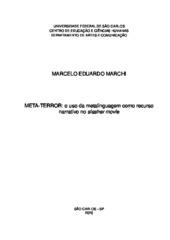| dc.contributor.author | Marchi, Marcelo Eduardo | |
| dc.date.accessioned | 2020-06-19T00:33:40Z | |
| dc.date.available | 2020-06-19T00:33:40Z | |
| dc.date.issued | 2020-04-24 | |
| dc.identifier.citation | MARCHI, Marcelo Eduardo. Meta-terror: o uso da metalinguagem como recurso narrativo no slasher movie. 2020. Dissertação (Mestrado em Imagem e Som) – Universidade Federal de São Carlos, São Carlos, 2020. Disponível em: https://repositorio.ufscar.br/handle/ufscar/12934. | * |
| dc.identifier.uri | https://repositorio.ufscar.br/handle/ufscar/12934 | |
| dc.description.abstract | Slasher movies - horror films characterized by the well-known premise of the serial killer that terrifies a group of young people, such as The Texas chainsaw massacre, Halloween, Friday the 13th and A nightmare on Elm Street - were a tremendous success with audiences during the first half of the 1980s. However, after that peak, the subgenre went into clear decay, since the exhaustive repetition of its formula ended up saturating viewers. Interestingly, in the mid1990s, it was the self-reflexive use of that same formula that ended up revitalizing it: premiered in 1996, Scream achieved a huge box office, became a landmark in popular culture and gave rise to an unexpected trend of slasher movies investing on metacinema. With daring and creative films like Behind the mask: the rise of Leslie Vernon and The cabin in the woods, the post-Scream era of horror movies has left us a rich field of study regarding the use of metacinema as a narrative resource and the ability to reinvent a subgenre through its own limitations. Thus, this research seeks to carry out a historiographical synthesis of the slasher movie based on the works of authors such as Carol J. Clover, Adam Rockoff, Richard Nowell, Jim Harper, and John Kenneth Muir, with the main focus on the elements of metacinema that have been found since the beginnings of the subgenre, but which gained strength especially with the release of Scream. Based on this and in a deep film analysis of selected works, it will be possible to understand the particular way in which each film used these elements, as well as the role of metacinema in reviving the slasher and in the process of making its formula increasingly dynamic. | eng |
| dc.description.sponsorship | Não recebi financiamento | por |
| dc.language.iso | por | por |
| dc.publisher | Universidade Federal de São Carlos | por |
| dc.rights | Attribution-NonCommercial-NoDerivs 3.0 Brazil | * |
| dc.rights.uri | http://creativecommons.org/licenses/by-nc-nd/3.0/br/ | * |
| dc.subject | Slasher movie | por |
| dc.subject | Metalinguagem | por |
| dc.subject | Narrativa | por |
| dc.subject | Cinema de terror | por |
| dc.subject | Subgênero | por |
| dc.subject | Metacinema | eng |
| dc.subject | Narrative | eng |
| dc.subject | Horror movie | eng |
| dc.subject | Subgenre | eng |
| dc.title | Meta-terror: o uso da metalinguagem como recurso narrativo no slasher movie | por |
| dc.title.alternative | Meta-horror: the use of metacinema as narrative resource in slasher movie | eng |
| dc.type | Dissertação | por |
| dc.contributor.advisor1 | Gamo, Alessandro Constantino | |
| dc.contributor.advisor1Lattes | http://lattes.cnpq.br/8208629144314123 | por |
| dc.description.resumo | Os slasher movies – filmes de terror caracterizados pela conhecida premissa do serial killer que aterroriza um grupo de jovens, como O massacre da serra elétrica, Halloween: a noite do terror, Sexta-feira 13 e A hora do pesadelo - foram um tremendo sucesso de público durante a primeira metade da década de 1980. Porém, após esse auge, o subgênero entrou em clara decadência, uma vez que a repetição exaustiva de sua fórmula acabou por saturar os espectadores. Curiosamente, em meados da década de 1990, foi o uso autorreflexivo dessa mesma fórmula que acabou por revitalizá-lo: lançado em 1996, Pânico arrecadou uma enorme bilheteria, tornou-se um marco na cultura popular e deu origem a uma inesperada tendência, a dos slasher movies calcados na metalinguagem. Com produções ousadas e criativas como Por trás da mascara: o surgimento de Leslie Vernon e O segredo da cabana, a era do terror pós-Pânico tem nos legado um rico campo de estudo no que se refere ao emprego da metalinguagem como recurso narrativo e à capacidade de reinvenção de um subgênero através de suas próprias limitações. Assim, a presente pesquisa busca realizar uma síntese historiográfica do slasher movie com base nos trabalhos de autores como Carol J. Clover, Adam Rockoff, Richard Nowell, Jim Harper e John Kenneth Muir, tendo como foco principal os elementos de metalinguagem que são encontrados desde os primórdios do subgênero, mas que ganharam força especialmente com o lançamento de Pânico. A partir disso e de uma profunda análise fílmica de obras selecionadas, será possível compreender a maneira particular com que cada filme se utilizou de tais elementos, bem como o papel da metalinguagem no reavivamento do slasher e no processo de tornar sua fórmula cada vez mais dinâmica. | por |
| dc.publisher.initials | UFSCar | por |
| dc.publisher.program | Programa de Pós-Graduação em Imagem e Som - PPGIS | por |
| dc.subject.cnpq | LINGUISTICA, LETRAS E ARTES::ARTES::CINEMA | por |
| dc.subject.cnpq | LINGUISTICA, LETRAS E ARTES::ARTES::CINEMA::ROTEIRO E DIRECAO CINEMATOGRAFICOS | por |
| dc.publisher.address | Câmpus São Carlos | por |
| dc.contributor.authorlattes | http://lattes.cnpq.br/5205042029981999 | por |


